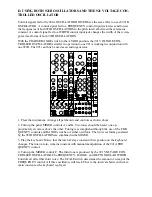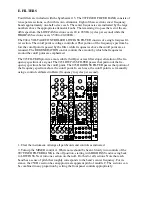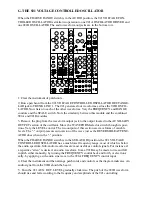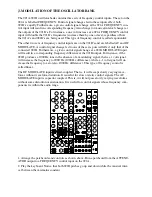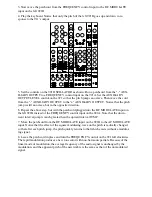
I. SYNCHRONIZATION OF OSCILLATORS
The 921B OSCILLATORS have inputs and switches for synchronizing their outputs with ex-
ternal signals whose frequencies are harmonically related. The external input signal is called
the synchronizing signal, while the 921B output is called the synchronized signal. One 921B
may provide the synchronizing signal, or some other oscillator, such as the 921, may be used
to synchronize both 921B’s.
When the frequency of the synchronized output signal is to be a whole number multiple (per-
fect overtone) of the synchronizing input signal, the synchronizing waveform should be a
sawtooth (as in the following example). When the frequency of the synchronized output sig-
nal is to be a whole number submultiple (perfect sub-harmonic) of the input synchronizing
signal, the input synchronizing waveform should be a sine. When synchronizing a 921B, the
SYNCH switch is normally in the STRONG position. For high waveform purity, use the
WEAK position. When a 921B is not being synchronized, the SYNCH switch should be in
the center (off) position.
995
904A
902
902
921A
921B
923
921
911
911
921B
MIXER
REV
CONTROLLERS
TRUNK
907A
0
0
8’
A
B
C
1 . Arrange all patchcords and controls as indicated.
2. Tune the left 921B to an octave above the 921, and the right 921B to an octave plus a fifth
above the 921. Listen to the beats produced by the mistuning. Flip the SYNCH. switches to
STRONG. Note the disappearance of the beats. The two 921B OSCILLATORS are synchro-
nized to the 921. The left 921B produces a second harmonic (first overtone) while the right
921B produces a third harmonic (second over-tone). Play the keyboard. Vary the FRE-
QUENCY control settings on the 921B to observe the range of "lock-in" over which synchro-
nizations is preserved.
3. Move the patchcord from the SAWTOOTH output of the 921 to its SINE output. Flip both
SYNCH.switches to the middle (off) positions. Set the frequency of the left 921B an octave
lower than that of the 921, and the frequency of the right 921B an octave plus a fifth lower.
Now flip the SYNCH. switches to their STRONG positions. Note the disappearance of beats.








